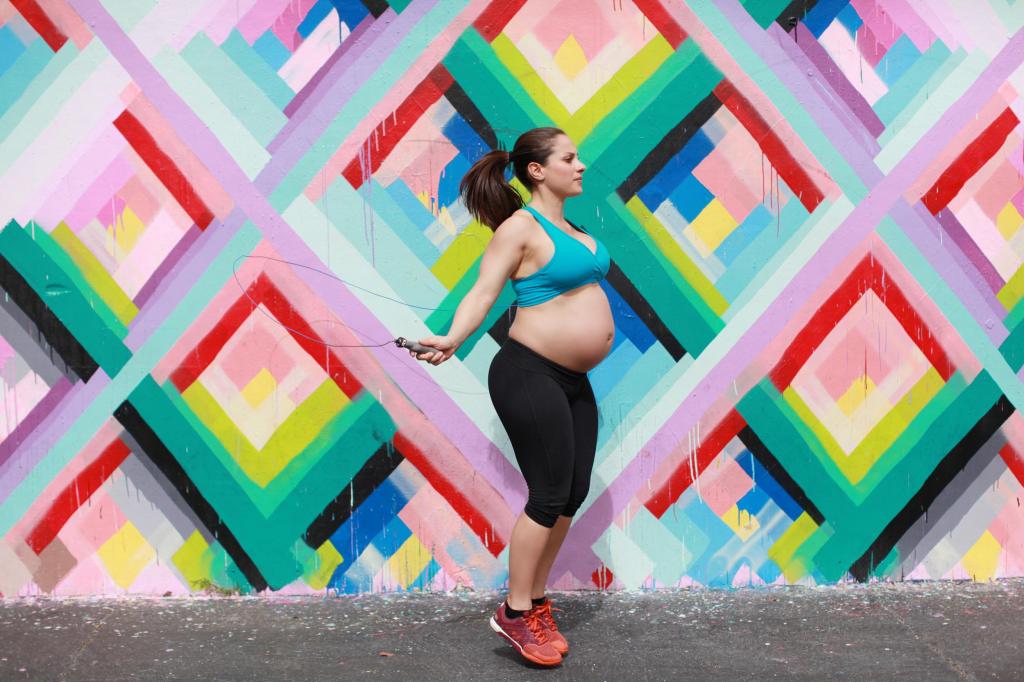CrossFit has the proven ability to deliver world-class fitness to all —including women who are pregnant.
As coaches, it is our responsibility to bring the workout to life for every athlete who comes to our classes, and this is done by scaling the workout.
CrossFit has provided a number of great resources on the art and science of scaling. From the newly released online Scaling Course to Jeremy Gordon’s CrossFit Journal article “Scaling CrossFit Workouts,” coaches can immerse themselves to learn more about this proven method of delivering general physical preparedness to athletes of all abilities.
To quote Jeremy Gordon, “CrossFit workouts are scaled to preserve the intended stimuli despite athlete limitations such as experience, injury, illness or range of motion. A properly scaled workout safely maximizes relative intensity (load, speed, range of motion) to continue developing increased work capacity despite limitations.”
The same general guidelines apply when scaling workouts for pregnant women, with a number of added considerations:

Some pregnant athletes feel uncomfortable upside down, but others have no issues at all. (Jessica Lopez)
- The overall health and safety of the mother and child.
- Physiological changes that impede some CrossFit movement patterns.
- Hormonal changes that affect muscles, tendons and joints.
- Changes by trimester.
- Careful application of relative intensity.
- Preserving the intended stimulus of movement patterns but not necessarily the metabolic output (intensity).
The purpose of this article is not to defend a woman’s right to CrossFit through pregnancy, nor to debate the safety of doing so. The purpose is only to share with the CrossFit community a template for scaling CrossFit movements for pregnant women.
This template was initially created in 2009, the first year we trained a pregnant woman at my affiliate, CrossFit Roots. Every pregnancy is different, and so the sheet continued to grow with various modifications that addressed expressed limitations such as “running feels uncomfortable” and “I don’t want to snatch around my belly,” among others.
The template took a big leap forward in 2013, when I became pregnant for the first time and my imagination let loose on all the ways I could scale movements to preserve the stimulus while growing a healthy baby and having fun doing it. At present, CrossFit Roots has trained over 30 women through pregnancy, and I’ve used this sheet through two pregnancies that yielded, in my opinion, two darling and daring little girls.
Of particular note, diastasis recti is a common concern. Simply put, it is a gap between the left and right side of the abdominals in pregnant or postpartum women. Most women experience some degree of abdominal separation during pregnancy as connective tissue stretches and thins to allow the uterus to expand and the baby to grow.
It is our belief that kipping contributes to greater potential for diastasis recti after childbirth because the movement can force muscle fibers beyond their current length. Many educators use the analogy of a rubber band: It can be stretched, but if stretched beyond its capacity, it loses its elasticity and will no longer retract to its original length. The result is small abdominal “pooch.”
At CrossFit Roots, we have recommended that all women stop kipping movement patterns at three to four months. Although we only have anecdotal evidence, this practice has worked for our pregnant women. Similarly, you’ll note we substitute a lot of plank work for movements such as sit-ups and toes-to-bars. An isometric contraction doesn’t promote abdominal separation and can build the midline stabilization needed to support a baby.

If skipping is uncomfortable, consider substituting kettlebell swings or AirBike work. (Jessica Lopez)
Scaling Is Scaling
Over the years, countless women have contacted me to inquire how they should train while pregnant. They often explain that their coaches can’t guide them because they’ve never been pregnant and don’t know how to scale for pregnancy. I’ve never broken a foot, had shoulder surgery, recovered from cancer, lost a lung in an accident, had a vasectomy, herniated a disc or cracked a rib, but I’ve coached people who have. You don’t have to experience pregnancy to scale for it; you just have to apply sound CrossFit principles:
Work within pain-free range of motion to preserve the intended stimulus and movement patterns whenever you can.
I hope this template can be a resource to affiliates, trainers and CrossFitting women.
Pregnancy: A Practical Guide for Scaling
| Movement | Modification and Scaling Options | Notes |
| Running | (1) 200-m sled drag with 25-45 lb. to replace 400-m run. Sled straps on shoulders. (2) Sled push. Use weight that makes for about a 2-minute effort. (3) Row 500 m. (4) AirBike 0.4-0.6 miles. | The sled, erg and AirBike will decrease impact that is often uncomfortable when running while pregnant. All these options will tax a metabolic pathway as running would. Adjust weight and/or distance to get the athlete to work for about the same amount of time she would spend on the running portion of the workout. |
| Double-unders | (1) Singles, or scale back the total number of double-unders. (2) 8-kg (17-lb.) kettlebell swings for half the number of doubleunder reps. (3) AirBike 15 seconds for 15 double-unders. | Jumping is often the first thing to become uncomfortable, so if jumping is out, go to the kettlebell or AirBike so the breathing patterns of double-unders can be reproduced. |
| Rowing | (1) Shorten the stroke length in the catch position and have the athlete push the knees out to the side. (2) Raise damper to 7 or higher because stroke length is greatly decreased. (3) Substitute sled pull, sled push or AirBike. | By 7 months, a lot of pregnant women find that while they can row, they can’t get any metabolic response because of their limited range of motion and stroke length. Substitute a sled pull/push or running if the athlete is still running. |
| Kettlebell Swings | (1) Lighter kettlebell. (2) Russian swings (to eye level). (3) Kettlebell deadlifts. (4) Hip extensions on the GHD or good mornings. | As the belly gets bigger, athletes can feel increased pulling on the front side of the body and pelvis. It bothers some, while others experience no discomfort. Discomfort can be reduced with swings to eye level and a major focus on contracting the abdominals. If dynamic movement causes discomfort, scale to deadlifts or hip extensions on the GHD. |
| Squats | (1) Adjust depth and load for comfort. | It’s all right for the athlete to load the squat, but generally they should not be straining excessively during lifting. Many women are comfortable staying below a percentage of pre-pregnancy 1-rep maxes. We use a guide of no more than 70 percent of 1-rep max for all loading past 3-5 months of pregnancy. Coaches will need to adjust some rep schemes (e.g., sub a 5 x 5 for a 1-rep max. Some women will feel comfortable going heavier). |
| Deadlifts | (1) Scale load. (2) Use sumo stance once belly interferes with thighs. | It’s all right for the athlete to load the deadlift, but generally they should not be straining excessively during lifting. Many women are comfortable staying below a percentage of pre-pregnancy 1-rep maxes. We use a guide of no more than 70 percent of 1-rep max for all loading past 3-5 months of pregnancy. Coaches will need to adjust some rep schemes; (e.g., sub a 5 x 5 for a 1-rep max). |
| Olympic Lifts | (1) Scale load. (2) Scale range of motion (e.g., lift from the hang instead of the floor). (3) Use dumbbells instead of a bar. (4) Change to the power version and consider adding a squat if a dynamic reception in the squat is uncomfortable (e.g., power clean plus front squat instead of squat clean). | Some have no problem doing barbell Olympic lifts throughout pregnancy, while others do not want to pass a barbell by the belly once it sticks out. Modify according to the athlete’s preference and comfort level with the movement pattern. |
| Pull-ups | (1) Strict pull-ups (with bands if needed); sub 1 strict rep for every 3 kipping reps. (2) Ring rows (don’t underestimate their potency). (3) Seated pull-ups to rings. (4) Bent-over dumbbell rows. (5) Rows on a low kids pull-up bar are a great scale and can allow the athlete to work on chest-to-bar range of motion. | Some women are just fine to kip throughout pregnancy. Others find it somewhat painful or experience a “tug” on their stomach. If that’s the case, strict pull-ups should be used. Past 3-4 months, some athletes choose to remove kipping motions because of the increased risk of diastasis recti. |
| Sit-Ups/GHD Sit-Ups/ Toes-to-Bars/Knees-to-Elbows (Eliminate After First Trimester) | (1) Plank hold. (2) Sideways walking plank. Travel horizontally in a plank position, about 20 feet for every 20 sit-ups (very challenging). (3) Side planks. | Eliminate sit-ups/toes-to-bars and any type of midline flexion similar to the motion of a sit-up once “coning” of the stomach is seen (the middle of the stomach becomes a little mountaintop). We want to allow the abdominals to grow apart at a natural pace inline with the growth of the baby and belly. We suggest eliminating anterior GHD work, sit-ups, toes-to-bars and movement patterns that involve flexion opposed to midline stabilization. |
| Box Jumps | (1) Scale box height. (2) Step-ups. (3) Weighted step-ups with dumbbells to a lower height (cut total reps in half). | Box jumps are similar to running: They sometimes feel jarring or uncomfortable. |
| Handstand Push-Ups | (1) Strict handstand push-ups. (2) Seated press with dumbbells. (3) Barbell shoulder press (strict or push press). (4) Standing dumbbell press on one leg with eyes closed. | Some feel fine going upside down on the wall or on a box. Adjust as needed for each athlete. Personal choice. The eyes-closed, one-foot option is great for working on balance and learning how to maintain tension throughout the body while pressing overhead. |
Click here to download the original PDF.
About the Author: Nicole Christensen is the owner of CrossFit Roots in Boulder, Colorado, and a Flowmaster for CrossFit Inc.’s Seminar Staff, leading both the CrossFit Level 1 and Level 2 certificate courses. She is the mother of two girls aged 3 and 1. When not spending time with her family, you can find Nicole on the gym floor coaching athletes during the morning and evening classes at CrossFit Roots.
Pregnancy: A Practical Guide for Scaling